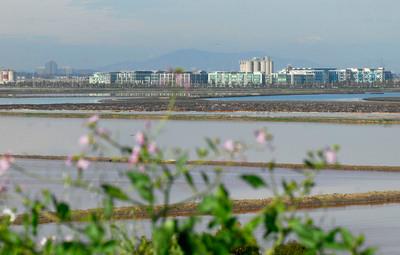The following Opinion piece was published on June 5, 2019, in the San Jose Mercury News.

Since our great awakening in the 1960s, the Bay Area has become a proud leader in protecting our local environment, from the redwoods and ridgelines to San Francisco Bay. We stopped shrinking the Bay with landfill and garbage dumps, cracked down on polluters and treated our sewage. We started restoring old salt ponds to lush tidal marshes for wildlife and flood protection, creating hundreds of miles of Bay Trail and shoreline parks.
But some wealthy developers don’t care, despite decades of being told, “no, we won’t build on the Bay anymore.” With Donald Trump’s help, Cargill Salt and luxury home developer DMB Associates keep putting their profit above the health of our Bay.
Sound familiar? In 2012, after years of massive public opposition, Redwood City officials halted the same companies’ project to build 12,000 homes on Bay salt ponds. They saw that “Saltworks” development would put people at risk from floods, destroy wildlife habitat, increase traffic and overtax city drinking water supplies.
Now Arizona-based DMB is back and trying to build on the Bay again, buoyed by the Trump administration’s attacks on federal environmental laws that protect wetlands and clean water.
But what made this the wrong place for housing before, hasn’t changed today. Endangered fish, birds, and other wildlife need more shoreline habitat not less. California laws still protect water, wetlands, and the wildlife that depend on them.
Cargill’s salt ponds are still a top priority for addition to the San Francisco Bay National Wildlife Refuge.
Redwood City zoning and land use rules still prohibit housing or other development on this “tidal plain” of the Bay – only agriculture or public recreation and parks are legal there.
Traffic is still terrible on Highway 101 and other roads near this site, which is miles from Caltrain. Building thousands of luxury condos there would add more cars, traffic and emissions.
What has changed since 2012? More reasons not to develop on Bay wetlands.
Bay Area residents are more concerned than ever about climate change and sea level rise because we’re already experiencing more extreme storms and floods. We know it’s not smart to put more people and buildings at risk in this flood zone.
We have better science on how our Bay can adapt to rising tides. A new report shows natural solutions are cheaper than seawalls, better for wildlife, and that the entire Saltworks site is suitable for tidal marsh, not new development. [“New Plan to Combat Sea Level Rise,” 5-2-19] . We understand this so well that more than 70 percent of us voted to tax ourselves in 2016 to accelerate Bay marsh restoration.
Marsh restoration is proceeding on either side of the Saltworks site – it’s the missing piece of a continuous wildlife corridor from San Carlos to San Jose.
To combat climate change and create more resilient and equitable communities, the Bay Area needs to add affordable housing near transit hubs, not pave over more wetlands. Redwood City has led Peninsula cities by adding thousands of new housing units downtown and on transit corridors this decade, with more coming.
Local politicians hear the public loud and clear without developer-sponsored forums to “Reimagine Saltworks.” Redwood City Mayor Ian Bain says, “The community wants to see the site restored to wetlands and there’s close to zero appetite for another housing proposal.”
Over the last 50 years, we’ve turned the tide to stop shrinking the Bay, embraced it as our greatest natural treasure, and restored its health. We can’t let the Trump Administration and misguided developers take us backward by destroying the Bay we love.
David Lewis is executive director of Save The Bay.

















































